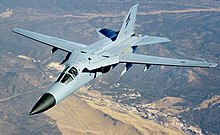Terrain follower radar
Terrain-following radar ( English terrain-following radar , TFR), and terrain following radar or rare ground tracking radar , is a technique which enables a low-flying aircraft, automatically maintain a relatively constant altitude above ground.
Process, technique and use
The system works by sending a radar signal towards the surface of the earth to the area in front of the aircraft that is to be overflown. The reflected rays are analyzed to determine the changes in the terrain. This information can then be used by the aircraft's autopilot to automatically maintain a constant altitude above the ground.
The technology is mainly used by aircraft used by the military to fly low at high speeds in hostile terrain. This is intended to make detection by enemy radar more difficult and enables flights even in poor weather conditions and in the dark.
Some aircraft, such as the Tornado , have multiple radars, with one system used exclusively for ground following flight. More modern aircraft like the Rafale can look forward and down at the same time with their phased array radar .
Military helicopters can also be equipped with terrain tracking radar. Because of their slower speed and good maneuverability, they can usually maintain a lower altitude than airplanes.
Terrain follower radar is also sometimes used in civil aviation, for example when it is desired to maintain a constant altitude above ground when taking aerial photographs.
Aircraft with terrain tracking radar
- A7A / B / C / D / E
- F-CK-1 C / D Hsiang Sheng
- Rockwell B-1
- B-2
- F-15E
- F-16E / F
- F / A-18C / D
- F-105
- F-111
- Dassault Mirage F1
- Dassault Rafale
- RF-4C
- Panavia tornado
- Tupolev Tu-160
- Sukhoi Su-34
See also
literature
- Krachmalnick, FM, Vetsch, GJ, and Wendl, MJ (1968) Automatic flight control system for automatic terrain-following (PDF file; 123 kB), Journal of Aircraft 5 (2), 168–175.
